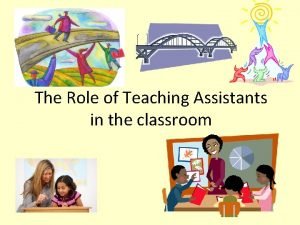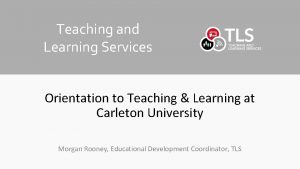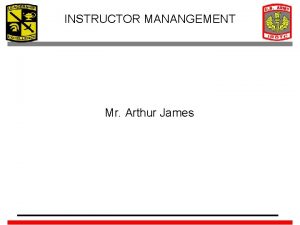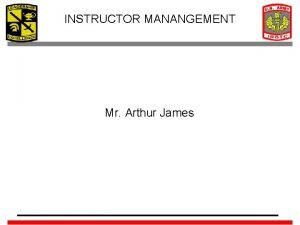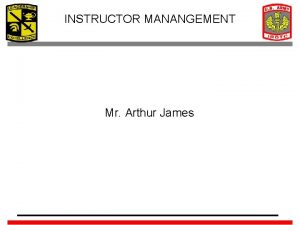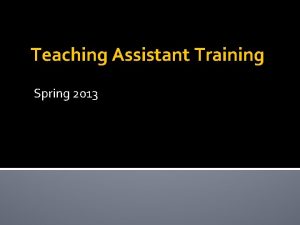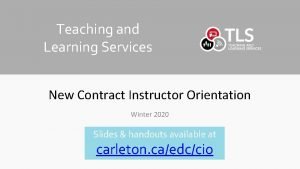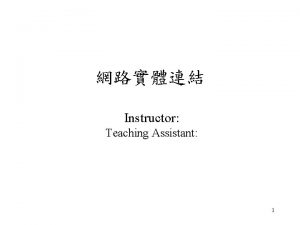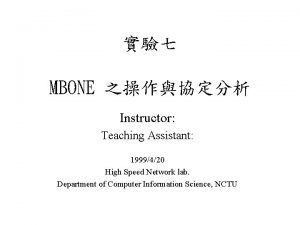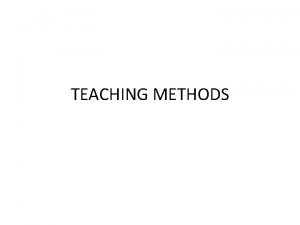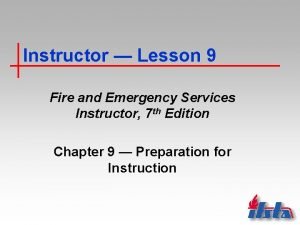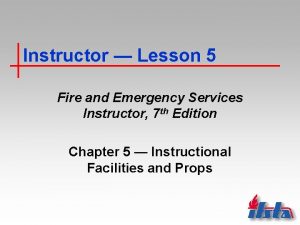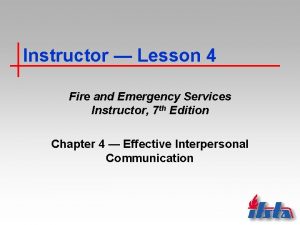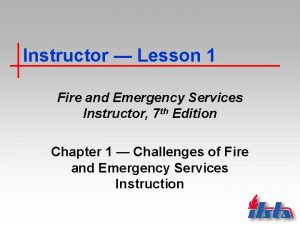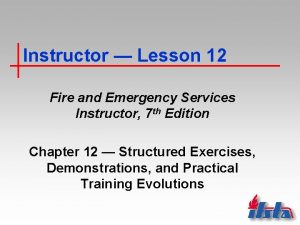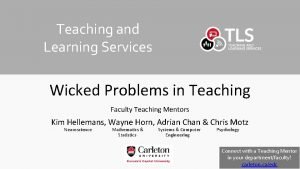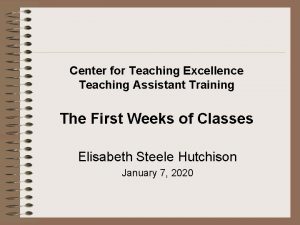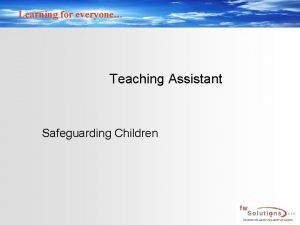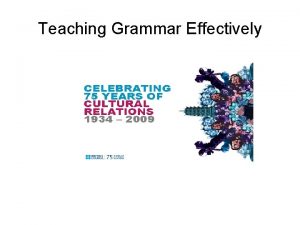Teaching assistant as a learning instructor Learning services























- Slides: 23

Teaching assistant as a learning instructor Learning services Planning officer Jenni Tulensalo, ELEC Learning Services 23 September 2020

Content • Learning services (LES) • Individual course arrangements • Code of Conduct • Misconduct and disruptions of student learning

Learning services (LES - School) • School/programme level support services for students, teachers and programme directors • For students: • service desk for administrative processes, applications and general advice, registration of course results • programme-specific study guidance and study planning • Student exchange • Arrangements of orientation, academic advising, introduction to studies -courses • For teachers • Systems support • Curriculum and study schedule work • Pedagogical support, digi peda support • For programme directors and academic leadership (deans) • Programme maintenance: degree programme committees • Events, statistics, admissions… • Programme development and evaluation All LES units: https: //www. aalto. fi/en/service-entities/learning-services In into: search programme -> contact information

Learning services (LES - U) Joint university learning services: • • Digital services for teaching and study administration: systems maintenance and support (eg. oodi, My. Courses, Sisu, Panopto) • Opit. aalto. fi (instructions, trainings) General teacher support (peda, digi peda – in school level as well) Study and career psychologists • Study skills (such as time management): https: //into. aalto. fi/display/enopisk/Study+skills Admissions services Lawyers Communications Strategic development projects

LES for teaching assistants • Individual course arrangements • Code of Conduct • Misconduct and disruptions of student learning • Course practices and administration https: //www. aalto. fi/en/services/course-implementation-fromteachers-view

Individual study arrangements

Individual study arrangements • Under the Non-discrimination Act (1325/2014) and the Aalto University General Regulations on Teaching and Studying, the university is obligated to take reasonable measures to improve the access to education of the student. • In Into: https: //into. aalto. fi/display/enopisk/Individual+study+arrangements • In Aalto. fi: https: //www. aalto. fi/en/services/individual-study-arrangements

A student may apply to receive personal study arrangements. The grounds include eg. • Seeing, hearing or other sensory impairment • Dyslexia • Visual-perceptual difficulties • Attention deficit and hyperactivity disorder • Autism spectrum disorders • Mental disorders • Anxiety and social anxiety • Panic attack and panic disorder

The special arrangements may include • extra hour in exam • possibility to take the exam in a room with no other students • possibility to demonstrate the attainment of the course learning outcomes also orally

The process for student 1. Contact learning services of your school/programme and agree a meeting. 2. Take necessary medical certificates to the meeting. 3. In the meeting the special arrangement options are discussed and decided. 4. A statement will be provided on the agreement. 5. Deliver the statement to the course teacher(s). Students should not contact the teacher directly. Students should agree on the individual study arrangements with the course teacher as far in advance as possible.

Code of Conduct

Rules of Conduct - Students´ Rights and Responsibilities (1. 8. 2020) • Students have the right to be treated equally, impartially and with mutual respect, to open and responsible communication, to respect of their privacy and property rights and to a healthy and safe environment for working and learning, as set forth in the Aalto University Code of Conduct. The students shall respect the corresponding rights of other Aalto University community members and other stakeholders acting in the Aalto community. • Misconduct by students includes, in accordance with the Universities Act, disruption of teaching, violent or threatening behaviour, dishonesty, and other disruption of university activities. • Aalto University employees are obliged to intervene if they receive knowledge of any misconduct directed at or committed by a student in the university environment and do so in a manner appropriate to the situation reporting as well the misconduct to the investigator of the school. Students who experience or otherwise observe misconduct by another member of the university community may report the issue to the investigator of the school. Rules of Conduct - Students´ Rights and Responsibilities: https: //into. aalto. fi/pages/viewpage. action? page. Id=28413237

Read through these instructions: • Rules of Conduct - Students´ Rights and Responsibilities: https: //into. aalto. fi/pages/viewpage. action? page. Id=28413237 • Code of Conduct in the University Environment https: //into. aalto. fi/display/ensaannot/Code+of+Conduct+in+the+Univ ersity+Environment

Misconduct and disruptions of student learning • A student who feels subjected to inappropriate conduct or other conflicts that interfere with course studies (problems in group work, for example) may directly tell the harassing or disruptive person to stop and that their behaviour is unacceptable. Should the misconduct or conflict continue, the student should first contact the teacher-in-charge of the course to resolve the situation. If necessary, the teacher may request the help of an investigator (usually Academic Affairs Manager). • A student who feels subjected to misconduct from a teacher, another staff member or a student, or who is experiencing problems with teaching arrangements or with other Aalto operations which have a bearing on student rights protection issues may contact the investigator. Instructions for investigating suspected cases of misconduct and disruptions of student learning: https: //into. aalto. fi/display/ensaannot/Instructions+for+investigating+suspected+cases+of+misco nduct+and+disruptions+of+student+learning

Misconduct in studying In a studying context, misconduct is first and foremost defined as a deliberate act or means of misrepresenting one's own or someone else’s level of competence (‘acts under false pretences’ in the Universities Act 558/2009). In addition, violating the rules regarding the testing of learning constitutes misconduct. Aalto University Code of Academic Integrity and Handling Violations Thereof: https: //into. aalto. fi/display/ensaannot/Aalto+University+Code+of+Academic+Integrity+and+Handling+Violations+Thereof

• Cheating on exams • NB! Also attempted cheating on an exam constitutes cheating • Plagiarism and Autoplagiarism • Plagiarism, or unacknowledged borrowing, refers to representing another person’s material as one’s own without appropriate references. This includes research plans, manuscripts, articles, other texts or parts of them, visual materials, or translations (Finnish Advisory Board on Research Integrity 2012, p. 33). • Fabrication • Fabrication refers to reporting invented observations or results to the research community (Finnish Advisory Board on Research Integrity 2012, p. 32). • Falsification • Falsification (misrepresentation) refers to modifying and presenting original observations deliberately so that the results based on those observations are distorted (Finnish Advisory Board on Research Integrity 2012, p. 33). • Misappropriation • Misappropriation refers to the unlawful presentation of another person’s result, idea, plan, observation or data as one’s own research (Finnish Advisory Board on Research Integrity 2012, p 33). Aalto University Code of Academic Integrity and Handling Violations Thereof: https: //into. aalto. fi/display/ensaannot/Aalto+University+Code+of+Academic+Integrity+and+Handling+Violations+Thereof

Guidelines for encountering a threatening individual 1. Give the individual room and let them maintain their turf. 2. Speak clearly, briefly and be compliant. 3. Keep your hands visible. 4. Do not turn your back. 5. Avoid sudden movements. Instructions for investigating suspected cases of misconduct and disruptions of student learning: https: //into. aalto. fi/display/ensaannot/Instructions+for +investigating+suspected+cases+of+misconduct+and +disruptions+of+student+learning# 6. Stay calm. 7. Avoid staring. 8. Do not minimize the situation or the threatening individual. 9. Better to bend than be inflexible. 10. Do not attempt to correct or disabuse the intoxicated or erratically acting individual of his or her delusions. 11. Gain time for others to arrive at the scene. 12. Attempt to report or send out an alarm without the threatening individual noticing. 13. If needed, call the emergency number 112. In case of emergency follow these instructions: https: //www. aalto. fi/en/services/procedures-in-case-of-emergency

If there is no immediate threat 1. The teacher calls on the threatening individual to cease his or her disruptive behaviour and, if necessary, to leave the premises. 2. The teacher reports the incident to the lobby services of the property or calls the Aalto. APUA helpline (050 46 46 462). Teachers do not have the right to attempt to physically remove the individual from the premises. After the incident • The teacher makes a record of what actions were taken and sends it to the investigator. If the teacher that day was not the course teacher-in-charge, contact the latter without delay. The teacher-in-charge of the course is responsible to see that the investigator is informed of the disturbance and that immediate measures are taken, regardless of whether the identity or student status of the disrupter has been verified. Instructions for investigating suspected cases of misconduct and disruptions of student learning: https: //into. aalto. fi/display/ensaannot/Instructions+for+investigating+suspected+cases+of+misconduct+and+disrupti ons+of+student+learning#

Typical reported cases By teacher: • Plagiarism (deliberate or unintentional) • Misconduct towards fellow student(s) By student: • Grading or evaluation principles (official grade appeals to Degree committee) • Teacher’s misconduct • Student misconduct/bullying

LES for teaching assistants • Individual course arrangements • Inform/suggest the possibility of individual arrangements. • Contact the learning services of your school for further information (there is a contact person in each school). • Misconduct and disruptions of student learning • If you notice or suspect misconduct (like cheating), inform the teacher in charge. • Contact the learning services of your school for further advice (head of academic affairs).

Questions

Q: What kind of metrics do LES use to evaluate their service performance or to monitor whether the delivered services have met students' needs. Also would like to know what are the biggest challenges they have encountered. A: Hard numeric metric: number of graduates and drop-outs, qualitative: eg. All. Well Survey, ISB (=international student barometer), Customer surveys conducted sometimes. Biggest challenge is to provide the right kind of support(service) at the right time in the right format… Q: If I as a teaching assistant see a student struggling with their studies, how could Learning Services help the student? I feel like just telling the student that this kind of service is available doesn't do much. Is there a way that Learning Services could contact the student directly? A: A common worry in LES as well. We can help students in many ways but we have trouble in reaching the students who would most benefit from those services. Student doesn’t need to know why she/he is struggling, just contact the coordinator/planning officer of her/his programme. By discussing with the student we can then evaluate what seems to be the problem and what could be done (checking study plan, re-scheduling studies, possibility to student psychologist, improving study skills etc. ) You are not allowed to report an individual (unless there is immediate threat) without consent. Try to justify, that LES people can really help. In the end individual student is her/himself responsible for seeking support.

Thank you! aalto. fi
 Role of a teaching assistant
Role of a teaching assistant Delmar cengage learning instructor resources
Delmar cengage learning instructor resources Micro teach meaning
Micro teach meaning Participante novato
Participante novato Basic instructor course tcole
Basic instructor course tcole Basic instructor course texas
Basic instructor course texas Basic instructor course tcole
Basic instructor course tcole Pepperball hotshot
Pepperball hotshot Not only the students but also their instructor
Not only the students but also their instructor Instructor vs teacher
Instructor vs teacher Cisco certified instructor
Cisco certified instructor Mptc firearms
Mptc firearms Basic instructor course texas
Basic instructor course texas Basic instructor course texas
Basic instructor course texas The virtual instructor elements of art
The virtual instructor elements of art Nfpa 1403
Nfpa 1403 Tp 12863
Tp 12863 Instructor operating station
Instructor operating station Catia instructor
Catia instructor Instructor
Instructor Ac61-98 plan of action
Ac61-98 plan of action Tcole 1014 basic instructor course
Tcole 1014 basic instructor course Marksmanship instructor
Marksmanship instructor How to become an nrp instructor mentor
How to become an nrp instructor mentor
